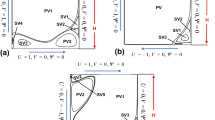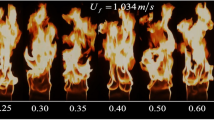Abstract
The unsteady growth of a viscous fluid plume beneath a rigid upper lid is investigated. Two-dimensional (planar) flow is assumed, through a fissure in the horizontal lower boundary. Initially, the fluid exiting the bottom is assumed to form a semi-circular region, but rises as time progresses, and spreads across the upper boundary. The problem is modelled using Boussinesq theory, and solved using a time-dependent spectral method. These numerical solutions are also compared with the results of a simpler inviscid asymptotic solution. Results are indicated for different input fluid speeds and fissure widths.





Similar content being viewed by others
References
Morton BR, Taylor GI, Turner JS (1956) Turbulent gravitational convection from maintained and instantaneous sources. Proc R Soc Lond A 234:1–23
Jia X, McLaughlin JB, Derksen J, Ahmadi G (2013) Simulation of a mannequin’s thermal plume in a small room. Comput Math Appl 65:287–295
Baines WD, Turner JS (1969) Turbulent buoyant convection from a source in a confined region. J Fluid Mech 37:51–80
Taylor GI (1945) Dynamics of a mass of hot gas rising in air. Atomic Energy Commission MDDC 919. LADC 276. Los Alamos National Laboratory Research Library
Woods AW (2010) Turbulent plumes in nature. Annu Rev Fluid Mech 42:391–412
Hocking GC, Forbes LK (2009) Steady flow of a buoyant plume into a constant-density layer. J Eng Math 67:341–350
Turner JS (1962) The ‘starting plume’ in neutral surroundings. J Fluid Mech 13:356–368
Tsang G (1970) Laboratory study of two-dimensional starting plumes. Atmos Environ 4:519–544
Griffiths RW, Campbell IH (1990) Stirring and structure in mantle starting plumes. Earth Planet Sci Lett 99:66–78
Davaille A, Limare A, Touitou F, Kumagai I, Vatteville J (2011) Anatomy of a laminar starting thermal plume at high Prandtl number. Exp Fluids 50:285–300
Forbes LK (2008) Spectral solution methods for free-surface flow: the Rayleigh–Taylor problem. ANZIAM J 50:549–568
Forbes LK (2009) The Rayleigh–Taylor instability for inviscid and viscous fluids. J Eng Math 65:273–290
Forbes LK, Chen MJ, Trenham CE (2007) Computing unstable periodic waves at the interface of two inviscid fluids in uniform vertical flow. J Comput Phys 221:269–287
Forbes LK, Paul RA, Chen MJ, Horsley DE (2015) Kelvin-Helmholtz creeping flow at the interface between two viscous fluids. ANZIAM J 56:317–358
Forbes LK (2014) Planar Rayleigh-Taylor instabilities: outflows from a binary line-source system. J Eng Math 89:73–99
Krasny R (1986) Desingularization of periodic vortex sheet roll-up. J Comput Phys 65:292–313
Williamson N, Srinarayana N, Armfield SW, McBain GB, Lin W (2008) Low-Reynolds-number fountain behaviour. J Fluid Mech 608:297–317
Williamson N, Armfield SW, Lin W (2010) Transition behaviour of weak turbulent fountains. J Fluid Mech 655:306–326
Farrow DE, Hocking GC (2006) A numerical model for withdrawal from a two-layer fluid. J Fluid Mech 549:141–157
Gray DD, Giorgini A (1976) The validity of the Boussinesq approximation for liquids and gases. Int J Heat Mass Transf 19:545–551
Lee HG, Kim J (2012) A comparison study of the Boussinesq and the variable density models on buoyancy-driven flows. J Eng Math 75:15–27
Christodoulides P, Dias F (2009) Impact of a rising stream on a horizontal plate of finite extent. J Fluid Mech 621:243–258
Milne-Thomson LM (1968) Theoretical hydrodynamics. Macmillan, London
Kreyzig E (1988) Advanced engineering mathematics, 9th edn. Wiley, Hoboken
Sharp DH (1984) An overview of Rayleigh–Taylor instability. Physica D 12:3–18
Yoshikawa T, Balk AM (2003) A conformal-mapping model for bubbles and fingers of the Rayleigh–Taylor instability. Math Comput Model 38:113–121
Batchelor GK (2000) An introduction to fluid dynamics. Cambridge University Press, Cambridge
Moore DW (1979) The spontaneous appearance of a singularity in the shape of an evolving vortex sheet. Proc R Soc Lond A 365:105–119
Hunt GR, Coffrey CJ (2009) Characterising line fountains. J Fluid Mech 623:317–327
van den Bremer TS, Hunt GR (2014) Two-dimensional planar plumes and fountains. J Fluid Mech 750:210–244
Lavelle JW (1995) The initial rise of a hydrothermal plume from a line segment source-results form a three-dimensional numerical model. Geophys Res Lett 22:159–162
Yannopoulos PC (2006) An improved integral model for round turbulent buoyant jets. J Fluid Mech 547:267–296
Moses E, Zocchi G, Libchaberii A (1993) An experimental study of laminar plumes. J Fluid Mech 251:581–601
Kaye NB, Hunt GR (2006) Weak fountains. J Fluid Mech 558:319–328
Lin W, Armfield SW (2000) Direct simulation of weak axisymmetric fountains in a homogeneous fluid. J Fluid Mech 403:67–88
Desrayaud G, Lauriat G (1993) Unsteady confined buoyant plumes. J Fluid Mech 252:617–646
Srinarayana N, Armfield SW, Lin W (2009) Laminar plane fountains impinging on a ceiling with an opposing heat flux. J Heat Mass Transf 52:4545–4552
Letchford NA, Forbes LK, Hocking GC (2012) Inviscid and viscous models of axisymmetric fluid jets or plumes. ANZIAM J 53:228–250
Acknowledgements
The authors would like to express their gratitude to two anonymous referees for their helpful comments.
Author information
Authors and Affiliations
Corresponding author
Rights and permissions
About this article
Cite this article
Russell, P.S., Forbes, L.K. & Hocking, G.C. The initiation of a planar fluid plume beneath a rigid lid. J Eng Math 106, 107–121 (2017). https://doi.org/10.1007/s10665-016-9895-1
Received:
Accepted:
Published:
Issue Date:
DOI: https://doi.org/10.1007/s10665-016-9895-1




